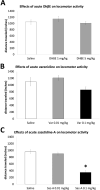Differential effects of α4β2 nicotinic receptor antagonists and partial-agonists on contextual fear extinction in male C57BL/6 mice
- PMID: 29383396
- PMCID: PMC5871575
- DOI: 10.1007/s00213-018-4837-4
Differential effects of α4β2 nicotinic receptor antagonists and partial-agonists on contextual fear extinction in male C57BL/6 mice
Abstract
Rationale: Numerous studies have attributed the psychopathology of post-traumatic stress disorder (PTSD) to maladaptive behavioral responses such as an inability to extinguish fear. While exposure therapies are mostly effective in treating these disorders by enhancing extinction learning, relapse of PTSD symptoms is common. Although several studies indicated a role for cholinergic transmission and nicotinic acetylcholine receptors (nAChRs) in anxiety and stress disorder symptomatology, very little is known about the specific contribution of nAChRs to fear extinction OBJECTIVES: In the present study, we examined the effects of inhibition and desensitization of α4β2 nAChRs via a full antagonist (Dihydro-beta-erythroidine (DhβE)) and two α4β2 nAChR partial-agonists (varenicline and sazetidine-A) on contextual fear extinction, locomotor activity, and spontaneous recovery of contextual fear in mice.
Methods: We trained and tested the subjects in a contextual fear extinction as well as an open field paradigm and spontaneous recovery following injections of DhβE, varenicline, and sazetidine-A.
Results: Our results demonstrated that lower doses of DhβE (1 mg/kg) and sazetidine-A (0.01 mg/kg) enhanced contextual fear extinction whereas higher doses of varenicline (0.1 mg/kg) and sazetidine-A (0.1 mg/kg) resulted in impaired contextual fear extinction. However, the higher dose of sazetidine-A (0.1 mg/kg) decreased locomotor activity, which may contribute to increased freezing response observed during fear extinction. Finally, we found that the low dose of DhβE, but not sazetidine-A, also decreased spontaneous recovery of contextual fear following fear extinction.
Conclusions: Overall, these results suggest that inhibition and desensitization of α4β2 nAChRs enhance extinction of contextual fear memories. This suggests that modulation of α4β2 nAChRs may be employed as an alternative pharmacological strategy to aid exposure therapies associated with PTSD by augmenting contextual fear extinction processes.
Keywords: Fear extinction; Nicotinic receptors; PTSD; Spontaneous recovery.
Conflict of interest statement
We declare no potential conflict of interest.
Figures




Similar articles
-
The contribution of α4β2 and non-α4β2 nicotinic acetylcholine receptors to the discriminative stimulus effects of nicotine and varenicline in mice.Psychopharmacology (Berl). 2017 Mar;234(5):781-792. doi: 10.1007/s00213-016-4514-4. Epub 2016 Dec 27. Psychopharmacology (Berl). 2017. PMID: 28028600 Free PMC article.
-
Dissociation between duration of action in the forced swim test in mice and nicotinic acetylcholine receptor occupancy with sazetidine, varenicline, and 5-I-A85380.Psychopharmacology (Berl). 2011 Sep;217(2):199-210. doi: 10.1007/s00213-011-2271-y. Epub 2011 Apr 13. Psychopharmacology (Berl). 2011. PMID: 21487659 Free PMC article.
-
Effects of sazetidine-A, a selective α4β2* nicotinic receptor desensitizing agent, on body temperature regulation in mice and rats.Eur J Pharmacol. 2012 May 5;682(1-3):110-7. doi: 10.1016/j.ejphar.2012.02.031. Epub 2012 Feb 24. Eur J Pharmacol. 2012. PMID: 22387853 Free PMC article.
-
The contribution of agonist and antagonist activities of α4β2* nAChR ligands to smoking cessation efficacy: a quantitative analysis of literature data.Psychopharmacology (Berl). 2018 Sep;235(9):2479-2505. doi: 10.1007/s00213-018-4921-9. Epub 2018 Jul 7. Psychopharmacology (Berl). 2018. PMID: 29980822 Review.
-
Recent developments in novel antidepressants targeting α4β2-nicotinic acetylcholine receptors.J Med Chem. 2014 Oct 23;57(20):8204-23. doi: 10.1021/jm401937a. Epub 2014 Jul 2. J Med Chem. 2014. PMID: 24901260 Free PMC article. Review.
Cited by
-
Nicotine modulates contextual fear extinction through changes in ventral hippocampal GABAergic function.Neuropharmacology. 2018 Oct;141:192-200. doi: 10.1016/j.neuropharm.2018.08.019. Epub 2018 Aug 28. Neuropharmacology. 2018. PMID: 30170085 Free PMC article.
-
Loss of GABA co-transmission from cholinergic neurons impairs behaviors related to hippocampal, striatal, and medial prefrontal cortex functions.Front Behav Neurosci. 2022 Nov 24;16:1067409. doi: 10.3389/fnbeh.2022.1067409. eCollection 2022. Front Behav Neurosci. 2022. PMID: 36505727 Free PMC article.
-
Nicotine Activating α4β2 Nicotinic Acetylcholine Receptors to Suppress Neuroinflammation via JAK2-STAT3 Signaling Pathway in Ischemic Rats and Inflammatory Cells.Mol Neurobiol. 2022 May;59(5):3280-3293. doi: 10.1007/s12035-022-02797-4. Epub 2022 Mar 17. Mol Neurobiol. 2022. PMID: 35297011
-
Identification of Critical Signature in Post-Traumatic Stress Disorder Using Bioinformatics Analysis and in Vitro Analyses.Brain Behav. 2025 Jan;15(1):e70243. doi: 10.1002/brb3.70243. Brain Behav. 2025. PMID: 39829117 Free PMC article.
References
-
- Alkondon M, Albuquerque EX. Diversity of nicotinic acetylcholine receptors in rat hippocampal neurons. I. Pharmacological and functional evidence for distinct structural subtypes. J Pharmacol Exp Ther. 1993;265(3):1455–1473. - PubMed
-
- Blanchard RJ, Blanchard DC. Crouching as an index of fear. J Comp Physiol Psycho. 1969;67(3):370–375. - PubMed
-
- Breslau N, Kessler RC, Chilcoat HD, Schultz LR, Davis GC, Andreski P. Trauma and posttraumatic stress disorder in the community: the 1996 Detroit Area Survey of Trauma. Arch Gen Psychiatry. 1998;55(7):626–632. - PubMed
-
- Breslau N, Davis GC, Schultz LR. Posttraumatic stress disorder and the incidence of nicotine, alcohol, and other drug disorders in persons who have experienced trauma. Arch Gen Psychiatry. 2003;60(3):289–294. - PubMed
-
- Breslau N, Novak SP, Kessler RC. Psychiatric disorders and stages of smoking. Biol Psychiatry. 2004;55(1):69–76. - PubMed
Publication types
MeSH terms
Substances
Grants and funding
LinkOut - more resources
Full Text Sources
Other Literature Sources

